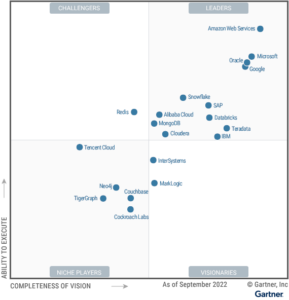The mad dash to the cloud continues, but now we’re entering a maturation phase that’s bringing more advanced capabilities for both analytical and transactional workloads in the cloud, Gartner analysts wrote in their latest report on cloud database management systems.
In their latest Magic Quadrant for Cloud Database Management Systems, Gartner analysts Henry Cook, Merv Adrian, Rick Greenwald, and Xingyu Gu sliced and diced the market for cloud database offerings, which accounts for more than half of the total database market. Twenty vendors made the final cut, which includes a mix of relational and non-relational databases, document stores, and data warehouses.
While there are winners and losers in the database horse race (a result of Gartner’s new “momentum index”), the ultimate winners are the database customers, who are gaining access to broad array of ever more-powerful capabilities for storing and processing data.
“There has been a general lifting of capabilities across the market,” the Gartner analysts wrote. “Whereas in the last two to three years, the emphasis has been moving to the cloud, often with basic capability, this last year has seen a marked maturing of the majority of offerings.”
For example, certain capabilities in analytical databases, such as built-in machine learning, low-code development, or multi-modality, would have earned the database an “advanced” label in previous years, they said, “yet now they are standard parts of many offerings.”
Similarly, a database customer may have been duly impressed if her transactional databases could process distributed transactions across many processors and geographic areas or could leverage hyperscale architectures. But now those capabilities are “normal,” the analysts wrote.
“For both types of systems, elastic scalability, SQL support (including for nonrelational databases) and the ability to mix operational and analytical working is becoming business as usual,” the analysts wrote. “Thus, all enterprises now have easier access to a wide range of database capabilities.”
Because cloud database capabilities are improving so quickly, Gartner warned customers not to pick a database based solely on a single feature. Most features are “copyable,” the analysts said, and if it’s valuable, it will be quickly copied by competitors.
So, how should prospective database customers pick a database? The number one metric is price performance, the analysts write. In particular, it’s the “price” side of that equation that’s really driving the needle at this point, they wrote.
“A key consideration is financial governance–the ability to predict, monitor and control costs,” the analysts wrote. “This is a common problem across all cloud-based systems where customers pay according to consumption rather than by an upfront investment.”
The cloud giants fared particularly well in Gartner’s Magic Quadrant, with AWS holding the most prominent spot, thanks to a broad array of database offerings and huge installed base. Microsoft Azure and Google Cloud also were prominently placed, along with relational database giant Oracle.
Database old guards IBM and SAP, both of which have considerable installations of on-prem relational database customers whom they are trying to move to the cloud, were also featured in the leader’s quadrant. Analytic database rivals Databricks and Snowflake also found themselves in the leader’s quadrant, along with Alibaba Cloud, NoSQL database king MongoDB, resurgent analytic database maker Teradata, and reformed Hadoop distributor Cloudera.
OEM database giant InterSystems, which is trying to become more visible, occupied the visionaries quadrant along with NoSQL vendor MarkLogic, which is being acquired by Progress. An open source multi-modal database, Redis, is the lone entry in the challenger’s quadrant.
Meanwhile, the niche players quadrant features two graph databases, Neo4j and TigerGraph, along with scale-out relational player Cockroach Labs and Couchbase, which sells a non-relational document store. Tencent Cloud also is listed in the niche players quadrant, all of whom were new entries to this Magic Quadrant except for Tencent Cloud. Gartner dropped four databases from last year’s report due to the market momentum index, including Exasol, Huawei, MariaDB, and SingleStore.

Data meshes and data fabrics figure to play prominently in database’s futures, Gartner says (Oleksii Lishchyshyn/Shutterstock)
The analysts made several other observations about the cloud database market, which accounted for the lion’s share the growth of the overall database market, valued at $80 billion. Momentum in open source databases continues to increase, they said, and there is also the trend of front-ending a database with a PostgreSQL or MySQL API, which have become industry standards.
We’re also seeing the rise of “data ecosystems,” the Gartner analysts said, which combines a specific database capability along with other integrated services. Customers can sign up for a data ecosystem from a single vendor, or build their own data ecosystem from multiple vendors.
Data meshes and data fabrics are also catching the eyes of analysts, who see greater participation and inclusion of databases in the years to come. The two architectural patterns will “entail a much greater degree of data management automation, metadata handling and interfacing, and incorporation of AI and machine learning into the business of data management itself,” the analysts write. “Although there are some very early indications of this in current offerings, this next wave has not yet begun but will likely begin another phase of disruption from 2023 onwards.”
Cloudera is sharing the Magic Quadrant for Cloud Database Management Systems. You can access it here.
Related Items:
Are Databases Becoming Just Query Engines for Big Object Stores?
Fivetran Benchmarks Five Cloud Data Warehouses
Cloud Now Default Platform for Databases, Gartner Says
The post Cloud Databases Are Maturing Rapidly, Gartner Says appeared first on Datanami.



0 Commentaires